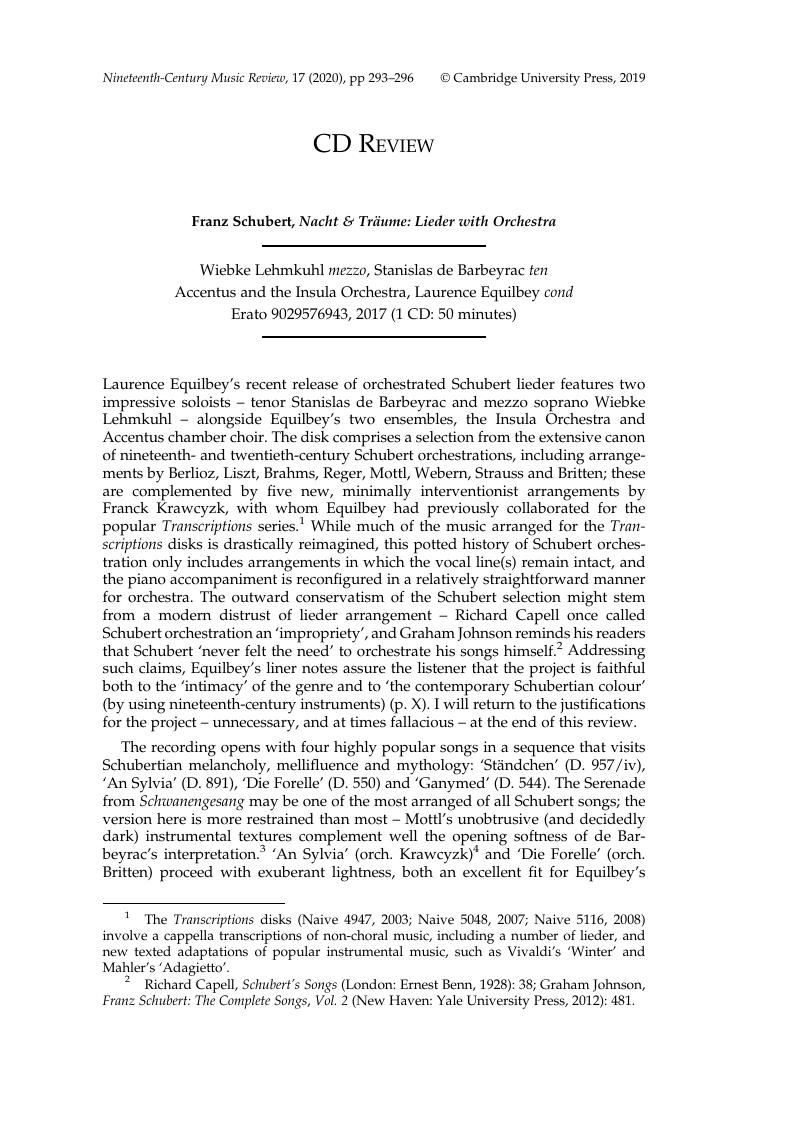No CrossRef data available.
Article contents
Franz Schubert, Nacht & Träume: Lieder with Orchestra - Wiebke Lehmkuhl mezzo, Stanislas de Barbeyrac tenAccentus and the Insula Orchestra, Laurence Equilbey cond Erato 9029576943, 2017 (1 CD: 50 minutes)
Published online by Cambridge University Press: 19 February 2019
Abstract

- Type
- CD Reviews
- Information
- Copyright
- Copyright © Cambridge University Press, 2019
References
1 The Transcriptions disks (Naive 4947, 2003; Naive 5048, 2007; Naive 5116, 2008) involve a cappella transcriptions of non-choral music, including a number of lieder, and new texted adaptations of popular instrumental music, such as Vivaldi’s ‘Winter’ and Mahler’s ‘Adagietto’.
2 Capell, Richard, Schubert’s Songs (London: Ernest Benn, 1928): 38Google Scholar ; Johnson, Graham, Franz Schubert: The Complete Songs, Vol. 2 (New Haven: Yale University Press, 2012): 481Google Scholar .
3 More extreme arrangements of ‘Ständchen’ include versions that appear in the Dreimäderlhaus reworkings Blossom Time (1921) and Lilac Time (1922), and, more recently, its appearance in D. J. Firehorse’s Shoebird (1999).
4 While Krawcyzk is credited online and in digital data for the orchestration of ‘An Sylvia’, the track list on the CD itself identifies the arranger only as ‘Anon’., leaving some uncertainty.
5 Youens, Susan, Schubert’s Late Lieder: Beyond the Song Cycles (Cambridge: Cambridge University Press, 2002), 83Google Scholar .
6 The two songs were published as Op. 43 by Pennauer in 1825. On different interpretations of ‘Die junge Nonne’ across its recording history, see Leech-Wilkinson, Daniel, ‘Sound and Meaning in Recordings of Schubert’s “Die junge Nonne”’, Musicae Scientiae 11 (2007): 209–236CrossRefGoogle Scholar .
7 On the song’s French reception and orchestrations in the 1830s, see Xavier Hascher, ‘Quand Schubert “entra dans la gloire”: Adolphe Nourrit et les versions orchestrées de “La Jeune Religieuse” et de “Roi des Aulnes”’, in Cahiers F. Schubert 19 (1999): 30–70. Liszt’s piano transcription is found in his 12 Lieder von Franz Schubert (S. 558/vi).
8 On Brahms’s Schubert orchestrations, and especially ‘Greisen-Gesang’, see Berry, Paul, Brahms Among Friends: Listening, Performance and the Rhetoric of Allusion (New York: Oxford University Press, 2014), 276 ffCrossRefGoogle Scholar .
9 On Schubert, Mayrhofer and ‘Mitternacht’, see Bretherton, David, ‘The Shadow of Midnight in Schubert’s “Gondelfahrer” Settings’, Music & Letters 92/1 (2011): 1–42CrossRefGoogle Scholar .
10 On the arrangement history of this song, see Christopher H. Gibbs, ‘The Presence of ‘Erlkönig’: Reception and Reworkings of a Schubert Lied’ (PhD diss., Columbia University, 1992).
11 The video is introduced on Insula Orchestra’s website: ‘La chef d’orchestre Laurence Equilbey pourrait être mise en examen pour contrefaçon, par atteinte au droit moral du compositeur Franz Schubert. Un reportage dans les méandres des Lieder orchestrés présenté par la journaliste Claire Chazal pour Classical Music News’. See ‘Le procès Schubert’, www.insulaorchestra.fr/en/c/le-proces-Schubert (accessed May 2018).
12 All quotes from ‘Le procès Schubert’, Parts 1–2, available on YouTube (English captions given, translations slightly modified).




